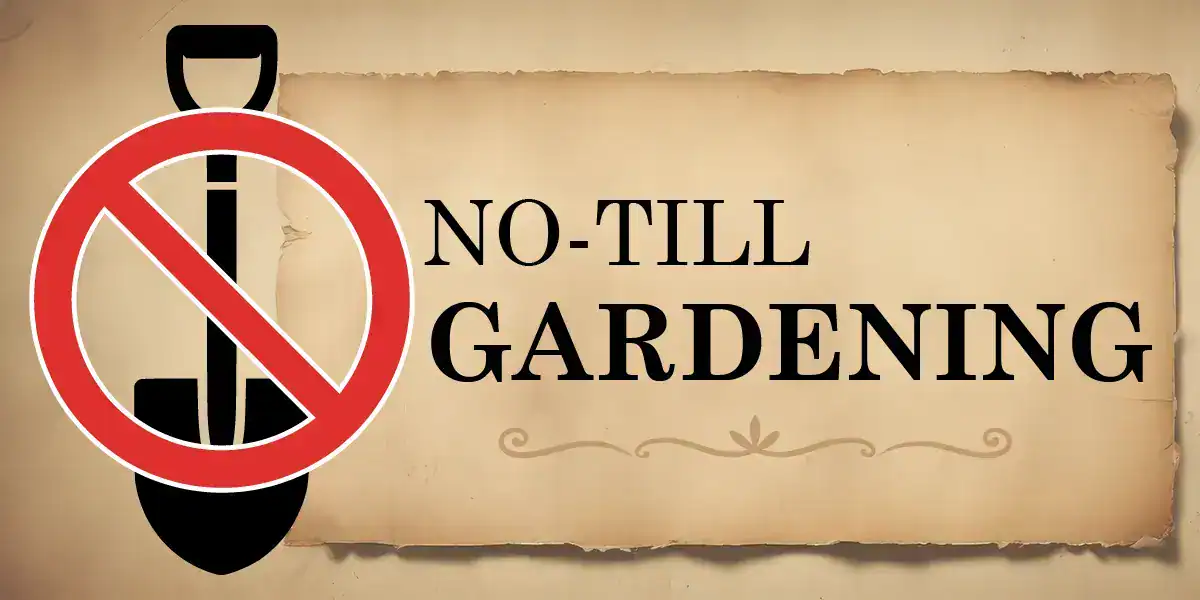Everything has its fads — even gardening.
- Pizza gardens with each “slice” growing a different pizza ingredient.
- Plant parenting, or treating garden plants like pets or children, complete with names, personalities, and even Instagram accounts.
- Moon gardening apps that give daily “cosmic planting advice.”
- Pet worm influencers who showcase their compost worms, name them, and document their “adventures” in vermiculture bins.
…Which brings us to no-till gardening, a hot topic in sustainable cultivation circles. Is it yet another passing fancy?
No, because unlike pizza gardening, no-till techniques have been practiced for centuries in traditional societies and are now finding a home in modern agriculture.
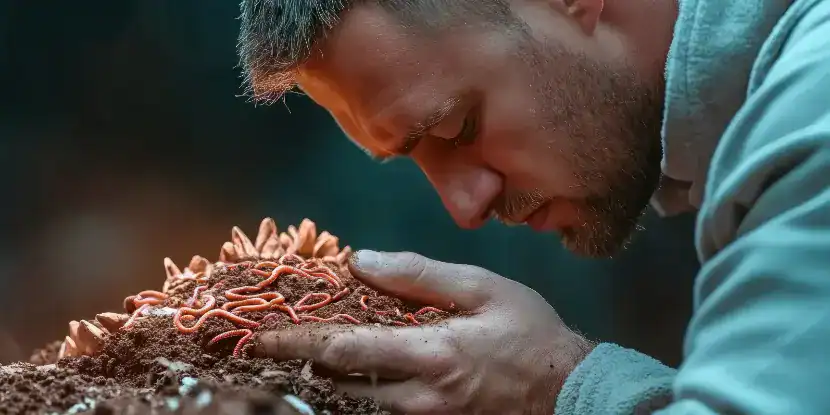
You, too, can be a worm influencer! Or you can leave the worms underground in your no-till garden.
What Is No-Till Gardening?
No-till gardening avoids tilling or plowing, leaving the soil intact and allowing beneficial organisms to flourish. It focuses on layering organic material on top of the soil, mimicking natural processes in forests and grasslands.
Ancient Roots
- Indigenous North American tribes used techniques like mulching, interplanting, and minimal soil disturbance, particularly in woodland and prairie systems.
- In Amazonia, people created “terra preta” (rich, dark soil) by layering organic material and biochar — essentially a no-till soil-building method.
- Farmers in parts of Africa and Asia used planting sticks or dibble tools to plant directly into unplowed soil.
These systems emphasized soil stewardship and long-term fertility rather than maximizing short-term yields.
Modern No-Till Farming Emerges
The modern no-till movement began in the 1940s–50s in the U.S. as a response to:
- Soil erosion caused by intensive plowing.
- The Dust Bowl disaster of the 1930s, which highlighted the destructive potential of conventional tillage.
- The rise of chemical herbicides, which made it feasible to control weeds without plowing.
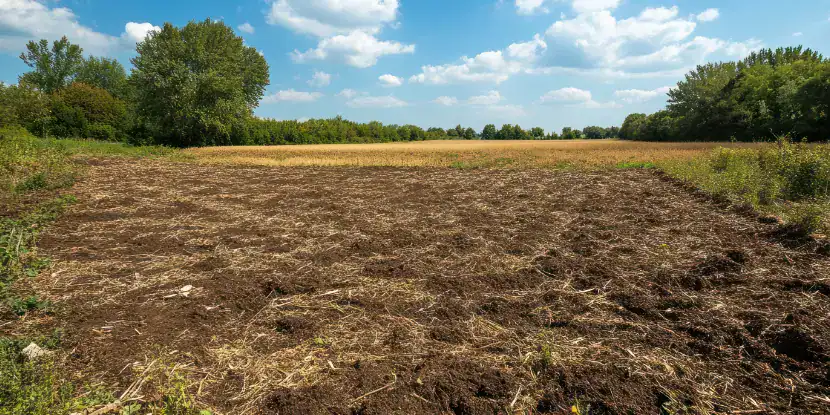
A no-till agricultural field covered in mulch and organic matter.
Core Principles of No-Till Gardening
- Preserve soil structure to maintain a thriving ecosystem of microorganisms, fungi, and insects.
- Minimize soil erosion by keeping the soil covered and protecting it from wind and water.
- Build fertile soil by decomposing organic layers like mulch, compost, and plant residue.
- Prevent soil compaction by avoiding heavy machinery and limiting foot traffic.
- Reduce the need for synthetic inputs, such as fertilizers and pesticides.
- Support water retention: Covered soil retains moisture, lowering the need for frequent watering.
Why No-Till Gardening Works Well in Southern California
Southern California’s environmental conditions — hot summers, limited rainfall, and varied soil types — make no-till gardening ideal.
1. Water Conservation
Water is a precious resource in Southern California. No-till gardening acts like mulch or straw, retaining soil moisture and hydrating plant roots.
2. Improved Soil Health
Southern California soils are often compacted or nutrient-depleted due to overuse and urbanization. No-till encourages healthy soil rich in organic matter.
3. Adaptable to Local Flora
Native and drought-tolerant plants flourish in no-till setups that replicate their natural environment.
4. Reduced Carbon Footprint
Undisturbed soil sequesters carbon and reduces greenhouse gas emissions. Maybe the state will give you a tax rebate (yeah, right)!
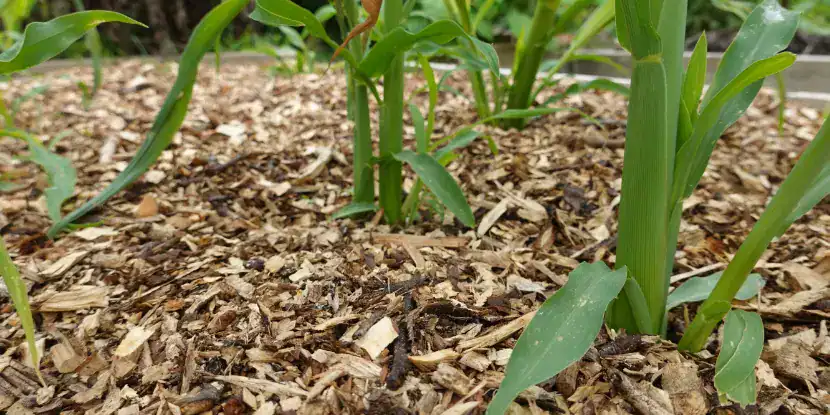
Ramial chipped wood mulch around growing corn stalks.
Methods & Best Practices for No-Till Gardening in SoCal
No-till gardening requires thoughtful planning and execution. Don’t count on TikTok influencers to come to the rescue!
1. Start with Mulching
Spread a thick layer of mulch — such as wood chips, straw, or shredded leaves — on your garden beds to suppress weeds, retain soil moisture, and protect the soil from harsh sun.
2. Use Cover Crops
Planting cover crops like clover, vetch, or rye during the off-season:
- Adds nutrients through natural nitrogen fixation.
- Protects against erosion during rainy or windy weather.
- Supplies organic matter when cut and left to decompose.
3. Apply Compost Regularly
Layer your garden with compost made from kitchen scraps, yard waste, or manure. Compost enriches the soil, supports microbial activity, and is a slow-release fertilizer for plants.
4. Avoid Soil Compaction
Stick to dedicated pathways in your garden to limit foot traffic on planting areas. This will prevent soil compression and keep your garden beds fluffy and aerated.
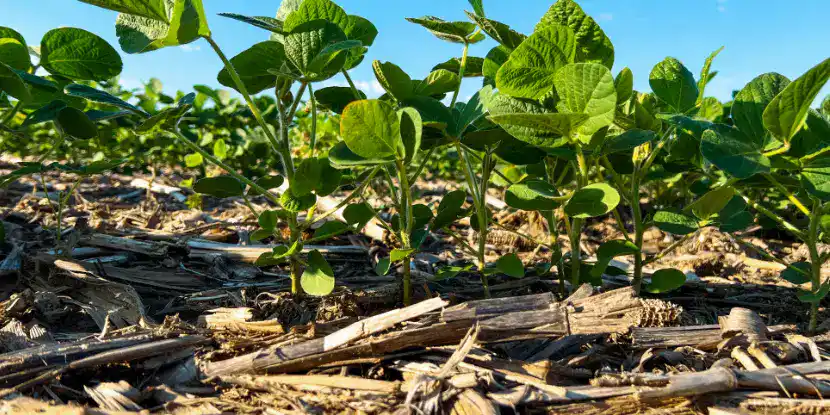
Young soybean plants in a no-till agricultural field.
5. Plant Densely
Interplanting or growing crops close together shades the soil, reduces water loss, and suppresses weed growth. For Southern California gardens, consider companion planting vegetables and drought-tolerant herbs.
6. Manage Weeds Effectively
While weeds are less of a problem in no-till gardens, spot-pulling or smothering with additional mulch may be necessary to keep them under control.
7. Plan for Irrigation
Drip irrigation systems deliver water directly to the roots while minimizing evaporation.
8. Monitor & Adjust
No-till gardening is a long-term strategy. Over time, you’ll notice healthier soil that requires less intervention.
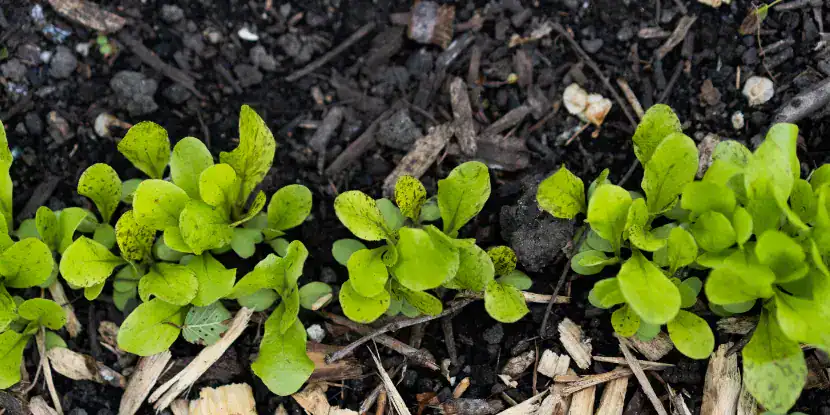
A row of lettuce seedlings in a no-till garden.
When No-Till Might Not Be Best
No-till doesn’t work in some conditions. Consider other methods when you face the following obstacles.
1. Persistent Weed Issues
If your garden already has an infestation of invasive or deep-rooted weeds, a traditional tilling pass might reset the soil and eliminate the problem before moving to a no-till system.
2. Extremely Compacted Soil
Heavily compacted soil may not absorb water or support plant roots. A one-time aeration or light tilling creates a foundation for no-till practices.
3. Limited Organic Matter
No-till relies on layering organic material. Without compost or mulch, it may be challenging to implement.
4. Time Constraints
No-till gardens improve with time as compost layers decompose and soil biology develops. If you need immediate results or your growing season is short, no-till may not offer the returns you expect.
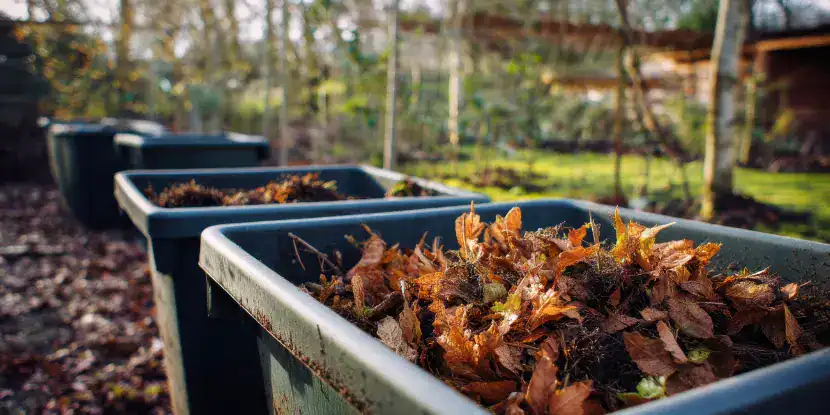
Leaves can be used for mulching or added to the compost pile.
FAQs: No-Till Gardening
Q: What is no-till gardening in simple terms?
No-till gardening means avoiding soil disturbance and enriching it with organic materials, creating a self-sustaining environment for plants.
Q: Why is it ideal for the Southern California climate?
It conserves water, improves soil health, and supports drought-tolerant plants — perfect for the region’s dry conditions.
Q: Do I need special tools for no-till gardening?
You can manage mulch, compost, and plant debris with shovels, rakes, and a wheelbarrow.
Q: Can I use a no-till method for vegetables?
Yes! No-till gardening works well for vegetables, especially with cover crops for soil fertility.
Q: Does no-till control pests effectively?
Healthy soil from no-till practices often makes plants more resilient to pests, reducing the need for chemicals.
Q: How long does it take for no-till gardens to show results?
It depends on soil health at the start, but noticeable improvements can occur within a few seasons.
Q: Do I need to fertilize no-till gardens?
With proper composting and mulching, additional fertilizers are rarely needed.
Q: Is tilling required in clay-heavy soils?
Clay soils may benefit from a one-time till to improve drainage before shifting to no-till.

